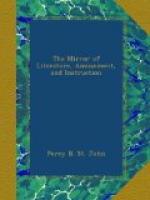Paper Linen.
According to the Paris papers, a new invention, called papier linge, has lately attracted much attention. It consists of a paper made closely to resemble damask and other linen, not only to the eye, but even to the touch. The articles are used for every purpose to which linen is applicable, except those requiring much strength and durability. The price is low, a napkin costs only five or six centimes (about a halfpenny), and when dirty, they are taken back at half-price. A good sized table-cloth sells for a franc, and a roll of paper with one or two colours for papering rooms or for bed curtains, may be had for the same price.
Maturation of Wine.
M. de St. Vincent, of Havre, states, from his own experience of long continuance, that when bottles containing wine are closed by tying a piece of parchment or bladder over their mouths, instead of using corks in the ordinary manner, the wine acquires, in a few weeks only, those qualities which is only given by age in the ordinary way after many years.—Nouveau Jour, de Paris.
Indications of Wholesomeness in Mushrooms.
Whenever a fungus is pleasant in flavour and odour, it may be considered wholesome; if, on the contrary, it have an offensive smell, a bitter, astringent, or styptic taste, or even if it leave an unpleasant flavour in the mouth, it should not be considered fit for food. The colour, figure, and texture of these vegetables do not afford any characters on which we can safely rely; yet it may be remarked, that in colour, the pure yellow, gold colour, bluish pale, dark or lustre brown, wine red, or the violet, belong to many that are esculent; whilst the pale or sulphur yellow, bright or blood red, and the greenish, belong to few but the poisonous. The safe kinds have most frequently a compact, brittle texture; the flesh is white; they grow more readily in open places, such as dry pastures and waste lands, than in places humid or shaded by wood. In general, those should be suspected which grow in caverns and subterranean passages, on animal matter undergoing putrefaction, as well as those whose flesh is soft or watery.—Brande’s Journal.
Zoological Society.
Dr. Brookes, in his address to the recent anniversary meeting of the Zoological Society, stated that the Museum already contains 600 species of mammalia, 4,000 birds, 1,000 reptiles and fishes, 1,000 testacea and Crustacea, and 30,000 insects. During the last seven months, the Gardens and Museum have been visited by upwards of 30,000 persons. The vivarium contains upwards of 430 living quadrupeds and birds. The expenses of the past year have been 10,000 l., partly contributed by the admission of the public, and still more largely by the members of the Society, who already exceed 1,200 in number. These are gratifying facts to every lover of natural history, as they serve to indicate the progress of zoology in this country—a study which it has ever been our aim to identify with the pages of the MIRROR.




